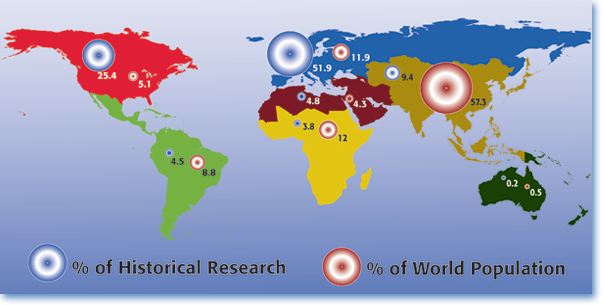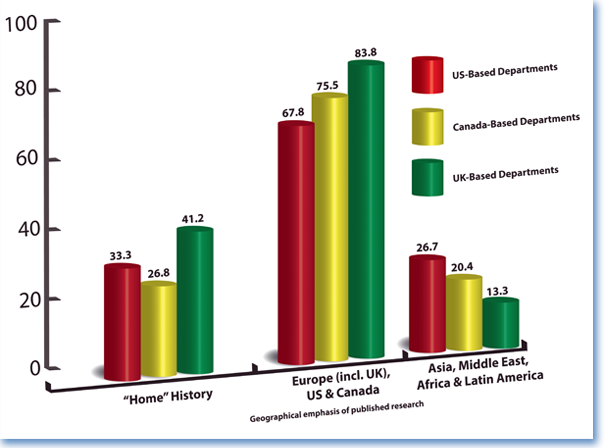Research
It's a Small World After All
The Wider World in Historians' Peripheral Vision
In the half century since the publication of E. H. Carr's famous polemic, the historical profession has done an admirable job of answering the question "What is History?" Confirming Carr's argument that the "facts" of the past are inseparable from the choices and approaches of historians, scholars have recovered the lifeways and struggles of ordinary people, challenging the primacy of intellectual and political history in the study of the past. But alongside our interest in what history should be, have we given much thought to the question of where our historical curiosity should be directed?
As historians who have taught on both sides of the Atlantic, we've long suspected that the range of academic history in the United States, United Kingdom, and Canada is overwhelmingly skewed towards Europe and North America. To test our hunch, we recently examined nearly 60 history departments from those three countries, comprising almost 2,400 historians in total, to assess how much non-Western history is being done in our most prestigious universities. Making our way through faculty web pages, we allocated historians to particular regions based on their published work. This task was sometimes straightforward: when you're reading more than 2,000 CVs, you develop an exhausted appreciation for scholars who've only ever written on France. At other times, it was extremely difficult: how to account for the scholar who works on ancient Egypt, modern espionage, and international environmentalism? We've explained our methodology on our website, where you can find a fuller breakdown of the results and a league table of all 57 institutions we sampled.
One fact quickly emerges: we're overwhelmingly interested in ourselves. Europe, the US, and Canada are the subject of more than three-quarters of all historical research in Britain and North America. Consider the mismatch between our historical curiosity and the population of the world's major regions (table 1 and fig. 1).
| Table 1. Disparities between World Population and Historical Research | |||
| Region | Percent of total world population |
Percent of total historical research |
Disparity index |
| U.K. & Ireland | 1.0 | 19.6 | + 19.6 |
| Canada | 0.5 | 6.2 | + 12.4 |
| U.S.A. | 4.6 | 19.2 | + 4.2 |
| Europe (excl. U.K. & Ireland) | 10.9 | 32.4 | + 3.0 |
| Anatolia | 1.1 | 1.7 | + 1.5 |
| Middle East/North Africa | 3.2 | 3.1 | -1.0 |
| Latin America | 8.8 | 4.5 | - 2.0 |
| Oceana | 0.5 | 0.2 | -2.5 |
| Sub-Saharan Africa | 12.0 | 3.8 | - 3.2 |
| East Asia | 23.6 | 5.8 | - 4.1 |
| Central Asia | 0.9 | 0.2 | -4.5 |
| South Asia | 23.9 | 2.5 | - 9.6 |
| Southeast Asia | 8.9 | 0.9 | - 9.9 |
| Figure 1: Historical Specialization vs. World Population The percentage of historians based in the United States, United Kingdom, and Canada whose specialty lies within a given region compared to that region's share of the world population. Excludes international, world, and Atlantic world historians. |
 |
Europe attracts three times as many historians as the raw population numbers would merit; the United States, around four times as many; for the United Kingdom and Ireland, the multiplier is nearly twenty. Conversely, historians of East Asia comprise only around a quarter of the numbers we'd expect from the population data.
Comparing results between the three countries we examined (fig. 2), US-based historians do a better job of covering the history of the wider world, while UK-based historians do worse. (Canada is in the middle.) US-based departments still focus overwhelmingly on Europe and North America: 68 percent of all publications are in these areas, with fully a third of historians working on the history of the United States. But US history departments have considerably more East Asian and Latin American history than UK and Canadian departments, though the United States lags behind the United Kingdom in the provision of South Asian history. A quarter of the "elite" US departments in our sample had no South Asian history whatever; around half had no one working on the history of Southeast Asia, and only a third had hired tenure-track faculty in the emerging field of world history. Plugging these gaps remains a major challenge even at the best-resourced universities.
| Figure 2: Comparing Georgraphical Range between US, Canadian, and UK History Departments |
 |
For those who think the history of the non-Western world matters, the UK picture is bleak. Britain lags behind the United States in African, Latin American, Middle Eastern, and especially East Asian history. (The proportion of historians working on East Asia in the UK is 1.9 percent, against nearly 9 percent in the US.) The obvious problem here is the extraordinary emphasis placed on British and European history in the UK system. While a third of US-based historians work on their own country, more than 41 percent of all historians in the United Kingdom work on British and Irish history. Meanwhile, 36 percent of UK historians work on continental Europe, against only 29 percent in US-based departments (fig. 3). This produces the most alarming statistic we discovered in our survey: in the United Kingdom, 84 percent of all historians work on the UK, Europe, or North America. Coincidentally, that's also the percentage of the world's population that lives outside those regions: 16 percent of UK historians are left to work on 84 percent of the planet's collective heritage.
| Figure 3: Percentage of Historians Working at US, Canadian, and UK Universities by Regional Specialism |
 |
Why don't history departments hire more people to work on the wider world? It would be hard to blame student demand. As immigration has made our nations more diverse, solipsism alone would lead us to focus on the countries and regions that have informed our national present. Students are also mindful of the challenges they'll face on the job market when they graduate. International possibilities, skills, and awareness are becoming important recruiting tools for college admissions, and are among the dividends most valued in the contemporary workplace. And yet departments currently struggle to cover the regions and stories that will shape the world's collective future. We run the risk of preparing our students to be citizens or administrators of a world order that has already passed.
Our geographical biases reflect an ingrained preference for Westerners over resterners, to borrow a phrase from Niall Ferguson. This preference isn't always manifested with the Grand Guignol of Ferguson's work ("I'm sure the Apache and the Navajo had all sorts of admirable traits..."), but its subtle effects are no less influential. A friend of ours at a major university told us about a recent meeting to discuss hiring priorities: when she advocated a post in African or East Asian history, since her department had no representation at all in those fields, she was told that a scholar of non-Western history might feel "isolated" as the only person working on that region. (Historians of US residential segregation might roll their eyes at this.)
Certainly Western students should be aware of their national histories and the history of Western civilization. At a moment when the place of history in schools and universities is under threat-both from legislators and rival subjects-we may still need to defend our discipline with a familiar instrumentalism: knowing about your country's past helps to consolidate national identity and citizenship, and to power what Brits call "the heritage industry." But it is odd to see nationalism exert a decisive influence on our research priorities given that the world had such a long history before its rise, and has changed so much since its zenith. Even "our Western heritage" is becoming increasingly global-as the "our" becomes more diverse, as historians reveal the "Western" to have always been more dependent on and more interlaced with the wider world, as "heritage" seems increasingly bounded by a circular argument: students are Western because they have received a Western civilization education, which was promoted at the expense of the wider world because these students are in fact Western. Why restrict ourselves to a corner of the planet when we could be heirs to a history and civilization that is in fact global?
You may assume that the ground has already begun to shift: aren't there more graduate students working on the wider world, and more job ads in non-Western fields, than ever before? We examined this question in our survey by recording the rank of each historian we examined. The results are mixed. In the United States, around 28 percent of full professors, and 38 percent of associate professors, work on the wider world. This implies that a surge took place in non-Western history hiring nearly a generation ago. But the figure for assistant professors is only 39 percent, implying that this surge may already have ended. The United Kingdom, incredibly, seems actually to have retreated: 15 percent of professors worked on the wider world, compared with 24 percent of mid-career academics and only 16 percent of junior hires. Only Canada showed a consistent growth in wider-world history across all three phases of an academic's career.
More on the Small World Full descriptions of the research, methods, and a ranking of institutions by wider-world interest are available on the authors' website (smallworldhistory.org).Watch Perspectives Online over the summer months for continued conversation on this topic. |
If we can't rely on a natural trend towards more cosmopolitan and wide-ranging history in our universities, what should we be doing to encourage this? It is hard to find arguments to convince a colleague who is prima facie unimpressed with the history of five-sixths of humanity, but clearly the current weighting of historical work poorly serves our students. On the assumption that we need to find ways to value the experience of other peoples and places, we make two suggestions:
1. Departments should ensure that every major world region has representation on the faculty.Even a single "isolated" faculty member in a particular region provides opportunities for undergraduates to learn about that part of the world, and minimal coverage is better than none at all. History departments in the United States have made progress in this area, and the goal of a faculty member for each major region is very much within reach for larger departments.
2. History departments should agree to a more representative balance of wider-world to Western history, and make hiring decisions accordingly. We neither advocate nor predict a perfect correlation between the population of a world region and the number of historians in North America and Britain who work on that region. But given the current, pronounced imbalance towards the history of the West, we think that a modest correction is both necessary and achievable. Our results suggest that all history departments should be moving south and east with all possible speed; we have a long way to go before there's any danger that we've gone too far.-Nicholas Guyatt teaches American history at the University of York in the UK.-Luke Clossey teaches world history at Simon Fraser University in Canada.
Tags: Diversity, Equity, & Inclusion Resources for Graduate Students Resources for History Departments Resources for Undergraduates
Comment
Please read our commenting and letters policy before submitting.






